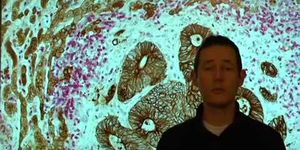NASA Wants to Know how Space Radiation Impacts the Body
Through the Human Research Program (HRP), NASA wants to find the safest ways to move humans through space. Charged particles are particularly interesting to scientists working in this area. Astronauts are exposed to a tremendous amount of those tiny particles as radiation when they’re in space, and it’s important to know the effect it has on the human body. The video below features NASA Space Radiation Element Scientist Lisa Simonsen, Ph.D. discussing what space radiation is.
"One of our biggest challenges on a mission to Mars is protecting astronauts from radiation," explained Simonsen. "You can't see it; you can't feel it. You don't know you're getting bombarded by radiation."
We think of radiation as being harmful, and might assume that the radiation in space is similar to what’s on Earth, but that’s incorrect. Our atmosphere and magnetic field have a major blunting effect on the radiation that actually gets through to us. We might also get exposed to X-rays at the doctor’s office, and can be protected from harmful effects caused by the rays simply by wearing a heavy lead shield.
Space radiation is not the same though. It contains enough energy to violently collide with nuclei that are the basis of matter, the stuff human cells and metal shields are made of. These nuclear collisions result in the breakup of both incoming space radiation and the nuclei it hits. New particles are thus created, called secondary radiation.
"In space, there is particle radiation, which is basically everything on the periodic table, hydrogen all the way up through nickel and uranium, moving near the speed of light," said NASA Research Physicist Tony Slaba, Ph.D. "NASA doesn't want to use heavy materials like lead for shielding spacecraft because the incoming space radiation will suffer many nuclear collisions with the shielding, leading to the production of additional secondary radiation. The combination of the incoming space radiation and secondary radiation can make the exposure worse for astronauts."
The focus of the HRP is to determine how space radiation impacts the human body, particularly what effects galactic cosmic rays (GCRs) have. "There are three main sources of space radiation, but GCRs are of most concern to researchers for a mission to Mars," explained NASA Research Physicist John Norbury, Ph.D. "GCRs that come from exploding stars known as supernovae outside the solar system are the most harmful to the human body."
Other sources of space radiation exist, like the Van Allen Belts, or during solar particle events that are associated with times of intense solar activity, coronal mass ejections and solar flares. GCRs are the primary problem, however, for HRP researchers who are tasked with protecting astronauts from space radiation.
Accurate data collection remains a challenge for the HRP scientists. While NASA has a Space Radiation Laboratory (NSRL) to simulate conditions, it’s difficult to accurately reproduce the experience of an astronaut who may be in space for an entire year.
NASA continues to prepare for a mission to Mars and will utilize every technology at its disposal to protect astronauts. There are a variety of critical instruments, like Orion's Hybrid Electronic Radiation Assessor, to monitor some very tiny particles with a big impact.
Sources: AAAS/Eurekalert! Via NASA









